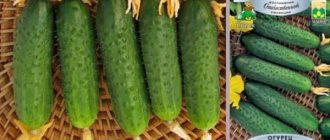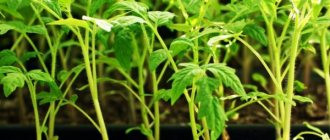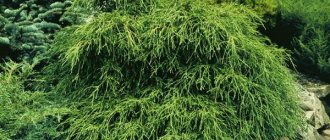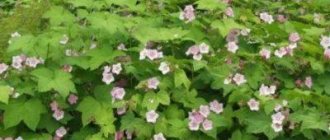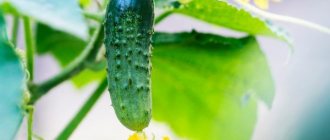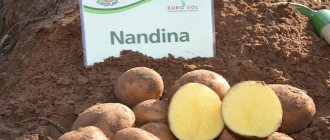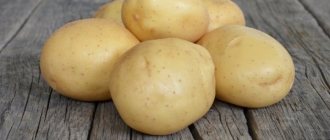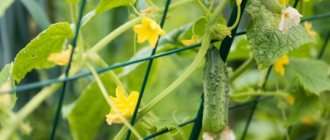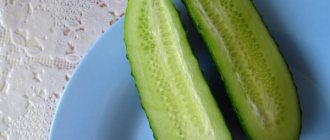Vegetable growing » Cucumbers
1
2061
Article rating
Kira Stoletova
The cucumber variety Babushkin Secret has recently been grown by Russian gardeners. This parthenocarpic hybrid is chosen mainly for growing in a greenhouse, because they do not require pollination, and the ovary is formed in any weather conditions. It is grown indoors in the northern regions. You will be pleased with your harvest even on the balcony or windowsill.
Characteristics of cucumbers of the Babushkin Secret variety
The variety was included in the State Register of the Russian Federation only in 2015. Agricultural firms, summer residents and gardeners appreciate its advantages.
Description of cucumbers Grandma's secret
Cucumber Babushkin secret f1 is a real surprise from Russian breeders, created in 2015 for cultivation in regions with a wide variety of climatic conditions. Cucumbers become most productive in temperate climate zones.
Cucumbers are grown not only in garden beds. It is excellent for cultivation at home: the variety is grown on a balcony or loggia.
Grandmother's secret is a mid-season variety of cucumbers, the harvest of which begins 40-50 days after the formation of the first seedlings.
Characteristics of the variety:
- A plant of indeterminate type with moderate climbing and strong, medium-sized shoots;
- Flowering type of the variety is bouquet;
- Grandma's secret is a parthenocarpic variety that does not require pollination by insects;
- Description of the cucumber: the fruits are cylindrical in shape and reach a length of up to 13 cm;
- The peel of the fruit is tender, but resistant to damage, with densely spaced large spines and a rich green color;
- Description of the pulp of the variety: dense, crispy, juicy, without empty formations;
- Taste characteristics of the variety: sweet cucumber, not bitter;
- Use: Cucumbers are suitable for making salads and also for canning.
Cucumber variety Grandma's secret (F1)
Cucumber / 01/14/2019 / (Votes 1 / 5.00 out of 5) Loading…
Another new product in the family of bunch cucumbers is called Grandma's Secret.
The peculiarity of this variety is that it does not require pollination, is not afraid of cold weather and produces excellent yields. An application for registration of this variety in 2013 was received from Agrofirm Aelita LLC.
In 2015, the new product was included in the State Register of Breeding Achievements of Russia with admission to all regions of the country. And although the plant has not yet become widespread among ordinary gardeners, vegetable growers in cool regions have appreciated its characteristics.
After variety testing, cucumber is recommended for cultivation in open ground and under film covers on private farms. It is a hybrid, so it is always labeled F1.
Description
The plant is indeterminate, the degree of branching is average. The leaves are long-petiolate, dark green, angular-heart-shaped, entire, with a slightly wrinkled surface. Female flowering type.
The type of fruiting is bunched, which significantly increases the overall yield.
Grandmother's secret puts 2 - 3 flowers in each leaf node, but some tomato growers say that you can get up to 4 flowers in a node with good care.
The variety's greens are small, cylindrical in shape, 10 - 12 cm in size, and not thick. The color of the fruit is green, with short light stripes. The surface of cucumbers is slightly ribbed, covered with large, frequent tubercles. The pubescence is complex and light. Some gardeners complain about the strong thorniness of the cucumber. The pulp is juicy, tender, crispy, dense.
The taste is sweet, there is not even a trace of bitterness. The State Register describes the taste as excellent. The seed chambers are small. The seeds are at the stage of milky ripeness and are practically not felt during consumption. The weight of greens, according to the State Register, ranges from 80 to 105 grams. Other sources indicate the weight slightly lower - 80 - 90 grams.
According to reviews from gardeners, the average weight of greens is a little more than 60 grams.
Pros and cons of the variety
Grandma's secret f1 is a cucumber variety that is of interest to many vegetable growers due to the list of positive characteristics, the description of which is given below.
pros
- High level of productivity of the variety (up to 9 kg of fruits per 1 m2 in garden beds, and up to 13 kg of cucumbers at home);
- Relatively early ripening of cucumbers;
- Resistance of the variety to infections;
- Grandmother's secret is resistant to various climatic conditions and sudden changes in weather conditions;
- Versatility in the use of fruits;
- Grandma's secret f1 has excellent taste characteristics and presentation;
- Resistance to transportation and shelf life of the product.
Minuses
Despite the large list of advantages of growing Grandmother's Secret f1, experience in cultivating the variety has shown that cucumber needs systematic watering, regular fertilizing and timely harvesting of fruits.
Cucumber Grandma's secret F1: characteristics, agricultural technology, reviews
Lovers of cucumbers with medium-sized fruits will appreciate the hybrid Grandma's Secret. This is an unpretentious and productive plant for small farms and garden plots. Familiarize yourself with the characteristics of the variety, the characteristics and description of the fruit, agricultural technology and the opinion of gardeners.
Detailed description of the hybrid
A domestic hybrid of cucumbers called Grandmother's Secret appeared on the seed market in 2015. The originator is Aelita. The plant is included in the selection State Register and is approved for planting in OG or spring greenhouses throughout the agricultural territory of the Russian Federation. The manufacturer calls the variety a cold summer cucumber.
The culture consists of indeterminate, but short lashes. The leaves are dark and medium in size. Cucumbers ripen 2-4 copies in each bosom. The harvest of greens is one-dimensional (see photo), and does not tend to exhibit bitterness in taste. The skin density is moderate; there is short white pubescence on the surface. The structure of the pulp is homogeneous and dense.
Advice. The cucumber is prized by pickle lovers. Fruits 4-5 cm long are suitable for this role.
| By type of growth | Medium-climbing |
| By type of branching | Medium branched |
| By type of pollination | Parthenocarpic |
| Planting scheme | 50×30 cm |
| Weight, length and shape of the fruit | 80-150 g, 9-11 cm, short, cylindrical, green, medium tuberculate |
| Ripening period | Mid-early (46-50 days) |
| Usage | Universal |
| Drop off point | Exhaust gas and film covers |
| Diseases | Immune to cladosporiosis |
| Flowering type | Female |
| Productivity | In the exhaust gas - 5-6 kg/m2, in the greenhouse - 12-15 kg/m2 |
Advantages and Disadvantages of Culture
Cold resistance is a useful quality for any cucumber. Aelita's hybrid copes well with changes in summer air temperature. It also successfully resists pathogens associated with such weather in garden diseases. In addition to enhanced immunity to cladosporiosis, cucumber has reduced tolerance to true and downy mildew, POM.
Other positive characteristics:
- High yield. Good yield of commercial quality cucumbers.
- Lack of barren flowers.
- Excellent taste properties.
- Precocity. In warm regions you can harvest on the 40th day.
- Good transportability and keeping quality.
Attention! Because of these advantages, the variety is successfully grown even in the unstable climate of the north.
Minuses:
- productivity in open ground is significantly lower than in a greenhouse;
- in exhaust zones, due to pollination by bees, cucumbers may taste bitter;
- It will not be possible to repeat planting from independently collected seeds.
Features of hybrid agricultural technology
The crop is grown using seedlings. The bushes are transplanted to the site at the age of 20-25 days. Placement density - 2-3 copies per 1 sq. m. In a greenhouse, the bush is kept strictly in 1 stem, in the greenhouse 2 are allowed. Collect cucumbers regularly. New ones will appear in place of the removed ones.
Advice. In a greenhouse, secure the plant to a trellis.
| April May | Mid May | First ten days of June | Above the 2-3rd sheet | Second half of June/July-August |
| *dates are indicated for central Russia |
Reviews from summer residents
Reviews about this cucumber are gradually appearing on the Internet. A gardener with the nickname Medinilla (Kostroma) shared her growing experience. The hybrid confirmed the characteristics declared by the originator. But there were also disadvantages:
- The garden bed became infected with root rot. With the help of timely intervention, the woman coped with the disease.
- At the end of fruit ripening, the plant began to produce deformed cucumbers.
- Fruiting was relatively short.
The summer resident notes: the disadvantages could be the result of violations of agricultural technology. Her rating for the variety is “satisfactory.” Grandma's secret cucumber is a relatively young hybrid. It is not suitable for industrial cultivation, but it is suitable for planting on a private plot. An important feature of the culture is that productivity does not suffer even in the northern regions.
Landing Features
The yield of the Babushkin Secret f1 variety is significantly influenced by the area where the cucumber will be grown and the correct planting of the variety.
Landing dates
Using the sowing method, Grandmother's Secret seed is planted at the beginning of June. The second half of April - the first week of May is suitable for planting cucumber seeds for seedlings.
Site preparation
A well-lit and sunny area is suitable for cultivating cucumbers. Experts recommend choosing beds that are located to the south of the house.
In spring, it is recommended to loosen the plot of land to a depth of 3 cm, remove all unwanted plants and feed the beds with manure or droppings.
To prepare a site for planting a cucumber, it is dug up after harvesting the previous harvest, all weeds are removed and the soil is fed with fertilizers that contain potassium or phosphorus components.
Planting seeds
Before planting, the seeds of Grandmother's Secret f1 must be treated: soaked in a manganese solution for half an hour. Afterwards, experts suggest hardening the seed so that the seeds can easily withstand changes in air temperature. To do this, the cucumber seeds are dipped in hot water, and then in cold water and allowed time to dry.
In open soil, the cucumber is planted in holes, the depth of which reaches 2 cm, and the soil temperature reaches 15 degrees. Then the holes are sprinkled with a small amount of earth and watered with warm water. Before the sprouts appear, vegetable growers suggest covering the beds with film. Grandma's secret f1 seedlings are planted in peat pots up to 3 cm deep.
After planting, the future seedlings of the variety are watered and placed in a place well equipped with light with a temperature of up to 27 degrees.
Planting seedlings
Grandmother's Secret seedlings are transplanted into the beds at the moment when up to 5 full-fledged leaves have formed on each bush. Cucumbers are planted deep to the bottom leaf, sprinkled with soil and watered. In order for the plant to successfully pass the adaptation period, it is provided with film cover.
Planting scheme
It is recommended to plant Grandma's Secret f1 at a distance of 30 cm between bushes and 60 cm between beds. This planting scheme does not create inconvenience during harvesting and during plant care procedures.
Agricultural technology
The hybrid Grandmother's Secret is not demanding in terms of care and cultivation conditions. But the soil must be selected with an increased content of turf and humus. You should not plant the crop in the same bed where cucumbers have already grown.
Note!
For the full development of seedlings, it is necessary that the air temperature does not drop below +15 ° C.
It can be cultivated either by seedlings or by direct sowing in the ground. The seeds have excellent germination. For cultivation in greenhouses, it is rational to prepare seedling material. The hybrid is planted in a permanent place when 4 true leaves are formed.
Plants are sown in heated greenhouses in February. The hybrid is planted at the rate of 3–4 plants per square. 120 cm are left between the rows. If there are no plans to leave shoots on the sides, then the plantings can be made as dense as possible.
Landing
Hybrid cucumber does not require special care. The cultivation rules for this plant are as follows:
- The soil is needed as turf with the addition of humus and sand.
- You cannot plant in soil where cucumbers grew in the previous season, correctly - after tomatoes and cruciferous vegetables.
- The temperature should be kept above +15 °C.
The hybrid plant is grown both by seedlings and by seed. Seed germination is good. They are embedded to a depth of 15-20 mm. Cucumbers love moisture, loose, oxygen-enriched soil.
Basic Rules
Seedling material is usually prepared for a greenhouse. Young shoots are ready for replanting if they have 4-5 true leaves. Planting in beds is carried out according to the following scheme:
- the interval between holes in a row is 300-500 mm (3-4 bushes per square);
- between rows – 120 cm.
Note!
Row spacing depends on whether shoots are left on the side. If the entire harvest is concentrated in the center, then the bushes can be planted more often.
Vegetable growers practice various techniques. In cool weather, when a minimum of ovaries are formed, shoots are left on the side. The timing of fruit production increases, and so does the yield.
For those who want to get the earliest fruits with a quick return, you need to form the plant into one stem, pinching all the shoots on the sides.
Features of care
Might be interesting Tomato “Siberian early ripening”, an old and popular variety Pepper “Gladiator”: a worthy option for the new season The best varieties of cucumbers for open ground: characteristics and description
Cucumber crops respond well to the use of slurry. It is fed in the autumn at 10 liters per m2. The soil is dug up to a depth of 200-250 mm. Slurry or humus can also be used in the spring. To do this, dig 2 grooves with a depth of 250-300 mm at a distance of 700 mm. A 100 mm layer of slurry is poured onto the bottom, and a 150 mm layer of garden soil is poured on top of it.
When planting in beds, you can use an unusual method:
- The bed is covered with black PE (transparent is also possible).
- Next, above the grooves with slurry, holes 100 mm in size are made in it.
- 2-3 seeds are planted in them (to a depth of 20 mm) or seedlings, 2 bushes per hole.
- The edges of the film are sprinkled with soil.
- The top of the bed is covered with PE of the “spider web” type for warmth.
So the temperature is 3-4 higher than in the garden. It is also important that in such a situation the soil is not pressed down, moisture is retained, and weeds do not grow on it.
Water once every 7 days. In an insulated bed, cucumber plants develop more actively and bear fruit earlier. In open ground, water every 4 days with warm water. Moisturizing should be done in the afternoon (the foliage should dry out by morning). Since the rhizome of the hybrid is superficial, there is excessive consumption of moisture and it is necessary to pour:
- up to a bucket of water per m2 before flowering;
- 15 l during fruiting.
Once every 14 days, watering is combined with fertilizing. You can use mullein solution (1:10). Often the vines develop and bloom profusely, but the cucumbers do not set. In such a situation, it is useful to feed with superphosphate extract: 60 g per 10 liters of water. Both feeding and watering should be carried out correctly along grooves placed at a distance of approximately 150 mm from the plants. With this method, the rhizomes are not washed away, and the foliage will not be burned by the sun.
On a note!
To prevent diseases and improve oxygen circulation, the beds where the hybrid grows are regularly watered and weeds are removed.
To increase the yield, vegetables require full tying and pinching of shoots from the side. The hybrid is usually grown using the trellis method. When tying the stems, you need to pay attention so that the twine does not tighten the plant. Otherwise, the seedlings may die. When growing cucumber seedlings, it is recommended to loosen between the rows 3-4 times and weed the weeds as needed. The first loosening is carried out to a depth of 120-150 mm, the next ones at 50-60 mm away from the stem. It is forbidden to loosen deeper or closer, as there will be damage.
Treatment is stopped when 4-5 true leaves form on the plants, when the vines are still vertical. Timely harvesting provokes the formation of new ovaries. Their hybrid can form 2-6 in each sinus.
The variety is in demand, which is why cases of selling low-quality seeds have become more frequent. If you want to get a rich harvest of high quality with the expected qualities, then planting material must be bought in branded markets.
Care
To obtain a good yield, Grandma's Secret cucumber needs to comply with such agrotechnical procedures as watering, fertilizing, loosening the soil and forming bushes.
Watering
It is recommended to water Grandma's Secret daily. Water the cucumbers with warm water that has been infused in the sun or heated independently.
All watering work is carried out, as a rule, in the evening, when the sun has set. In addition, it is necessary to water strictly under the root system of the plant. Do not allow drops of water to fall on the leaves or shoots of the plant.
Garter and bush formation
When cultivating cucumbers in greenhouses, the plant is formed using a trellis method. As a rule, bushes are tied to supports using twine and care is taken to ensure that the shoots are not pinched. It is recommended to pinch the side stems at a distance of up to 50 cm. In this case, the main stem is tied to the trellis and directed downwards.
Top dressing
It is recommended to feed cucumbers once every 2 weeks. For fertilizing, use a solution of bird droppings or manure. In addition, to fertilize the variety, it is necessary to use an infusion of wood ash, as well as complex fertilizers that contain potassium, phosphorus, and superphosphate.
Hilling
Grandma's secret, like the Aquarius variety, does not need hilling. However, vegetable growers recommend not to forget about loosening and weeding the soil. It is necessary to loosen the soil carefully so as not to touch the roots of the plant. To do this, it is recommended to pierce the soil with a fork.
Views on growing varieties
You can grow Grandma's Secret by seed and seedlings. Sowing seeds for seedlings is carried out on the 20th of April. Seedlings can be planted under film covers at the age of 20 - 25 days, when at least 3 - 4 leaves appear on young plants. Seedlings are planted in an open bed in late May - early June.
Sowing seeds in open ground is carried out as soon as return frosts have passed and the temperature does not fall below 10 °C. This weather occurs in the last ten days of May - early June. The seeds are planted to a depth of about 2 cm. Planting pattern: 50 cm between bushes, 50 cm row spacing. Planting density - 3 - 4 plants per 1 square meter.
After transplanting, the seedlings are tied to a trellis. The variety is formed into one stem according to the following scheme. First, blinding is carried out by plucking out all the shoots, flowers and ovaries in the axils of 3 - 4 lower leaves. Then, in the next 3 - 4 leaf nodes, only the shoots are removed, but the flowers and ovary are not touched. In the next 3 - 4 nodes, the ovary and side shoots are left, removing the growth point on them after the first leaf.
In higher leaf nodes, shoot growth is limited after the second leaf. When the central stem of the cucumber reaches the height of the greenhouse, it is wrapped several times around the supporting support and pinched as soon as it reaches the neighboring plant. At the top, all side shoots are removed so as not to create thickening. Care is carried out as usual for the culture as a whole.
The new hybrid Grandmother's Secret has already proven itself in cold regions, as it is able to grow and bear fruit even with temperature changes, yielding crops early and quickly. Despite the fact that there are few reviews about the variety, from the available information we can conclude that the disease-resistant, unpretentious and productive variety will be of interest not only to ordinary gardeners, but also to small farmers who grow vegetables for sale.
The cucumber variety Babushkin Secret has recently been grown by Russian gardeners. This parthenocarpic hybrid is chosen mainly for growing in a greenhouse, because they do not require pollination, and the ovary is formed in any weather conditions. It is grown indoors in the northern regions. You will be pleased with your harvest even on the balcony or windowsill.
Characteristics of cucumbers of the Babushkin Secret variety
The variety was included in the State Register of the Russian Federation only in 2015. Agricultural firms, summer residents and gardeners appreciate its advantages.
Landing
Diseases and parasites
The hybrid variety is resistant to diseases such as downy mildew, cladosporiosis and powdery mildew. However, non-compliance with agrotechnical procedures leads to damage to Babushkin Secret plants by infections such as olive spot, root rot and fusarium.
Olive spot
Olive spot is a disease that causes small spots of brown or dark brown color to form on cucumbers, and the cucumbers themselves begin to curl. There is also the formation of small brown spots on the leaves and stems of the plant, which turn into cankers. To prevent olive spotting, Grandma's Secret bushes are sprayed with Bordeaux mixture or a solution of copper oxychloride.
Root rot
Root rot is an infection in which the roots of a plant begin to rot and turn brown. During hot weather, the plant begins to wither and the stem takes on a dark color. It is recommended to combat root rot with the chemicals Fitosporin, Gamair or Rizoplan.
Fusarium
Fusarium is a wilting of the tops of a plant, as a result of which the leaves turn yellow and the vines of the plant dry out. The disease attacks cucumbers, as a rule, at the moment of flowering or fruiting of the bushes. To prevent infection, the plant is treated with Previkur.
Advantages and disadvantages
After testing the variety, the cucumber crop is recommended for cultivation in the garden and in greenhouses, hotbeds, large-scale and small dacha areas. It is a hybrid variety and is therefore labeled F1.
Advantages of a hybrid:
- High fruiting – 6-8 kg per m2.
- No barren flowers.
- Vegetable growers speak well of the taste of the fruit.
- Versatility: they are used both for fresh consumption and for preparation.
- Resistant to many diseases of the pumpkin family and daily temperature fluctuations.
- Good preservation. In parthenocarpics, a bitter taste may also appear when the gherkins are deformed as a result of pollination of flowers by pollinating insects.
However, the hybrid also has disadvantages. If the flower stalks are pollinated by insects and the fruits become deformed, they may taste bitter. Vegetable growers will not be able to independently collect seeds and prepare them for next year. Even if female flower stalks pollinated by insects produce greens with seeds, it will not be possible to obtain plants exactly like the mother plant. This is the minus of all hybrids.
The culture is almost not infected with LMR, cladosporiosis, and MR. The new hybrid variety has already proven itself well in cold areas, as it can develop and produce crops even at low temperatures.
Characteristics of the variety, description of the hybrid
Grandmother's granddaughter F1 is a hybrid with early ripening. The cucumber is indeterminate, its lateral shoots grow at a moderate pace. The ovary is formed according to the bouquet type. Up to 4 fruits are formed in one node.
Cucumber of uneven green color. In the area of the stump the color is dark, at the place where the flower is attached - light. As you can see from the photo, yellow stripes are also visible on the skin. They reach the middle of the fruit. The cucumber is completely covered with whitish spines and tubercles, which smooth out when overripe.
Zelentsy reach a size of 10-12 cm. The seed sac is weakly expressed, the flesh is dense, without voids. The taste of the vegetable is pleasant, without bitterness.
| By type of growth | Medium-climbing |
| By type of branching | Medium branched |
| By type of pollination | Parthenocarpic |
| Planting scheme | 50x50 cm |
| Weight, length and shape of the fruit | 110 – 120 g, 10-12 cm, shortened, cylindrical, uneven green |
| Ripening period | Early ripening (38 – 43 days) |
| Usage | Universal |
| Drop off point | exhaust gas/greenhouse/greenhouse |
| Diseases | Resistant to root rot, cladosporiosis, powdery mildew |
| Flowering type | Female |
| Productivity | 12 – 12.8 kg/m2 |
Diseases
This variety is immune to cladosporiosis. It is moderately resistant to the cucumber mosaic virus, as well as to powdery/downy mildew. But there is evidence that in protected soil it is susceptible to root rot.
The main cause of root rot is poorly drained or waterlogged soil. These conditions prevent the roots from absorbing all the oxygen they need to live. As oxygen-depleted roots die and decompose, their rot can spread to healthier roots, even if those defects have been corrected.
A weakened rhizome is more susceptible to soil fungus, which is another cause of rotting. The fungus can remain in the soil for a long time, when the soil becomes waterlogged, the spores come to life and infect the roots, causing them to rot and die.
Many rot symptoms reflect signs of pest infestation, making proper diagnosis difficult. Manifestation of the disease:
- growth retardation or poor growth;
- small, pale leaves;
- wilted, yellowed or brown leaves.
The most accurate way to diagnose this disease is to dig underground to see if decomposition is occurring. In this case, it is advised to exercise great caution so as not to cause more harm to the plant. Root diseases are best controlled through prevention. Plant only in well-drained soil. Sometimes moderately affected plants can be saved by trimming the infected roots.
Important!
Be sure to disinfect any tools before using them again.
If a bush is severely infested, the best way to prevent the disease from spreading is to remove it completely. Chemicals such as Chloropicrin or Methyl Bromide do not completely cure the disease, but may reduce the level of infection.
Productivity
The cucumber variety Babushkin Secret (F1) gives a good harvest. From 1 sq. meters, 6-8 kg of fruits are collected. According to reviews from vegetable growers, when growing cucumbers in greenhouses, the yield increases significantly - up to 15-16 kg per 1 sq. meters of landing.
Hybrid Babushkin Secret (F1) is suitable for cultivation throughout Russia. In the southern regions, cucumbers produce a good harvest in unprotected soil, and in the middle zone they are grown under film covers. It is typical for the northern regions to grow cucumbers of the review variety in heated greenhouses.

